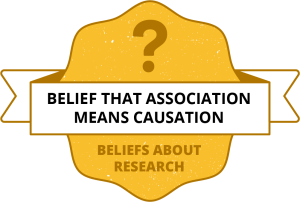 Don’t assume association (correlation) is the same as causation.
Don’t assume association (correlation) is the same as causation.
Just because something good or bad happens after a health action, it doesn’t mean the health action caused it. It could be just a coincidence or due to something else.
Explanation
Researchers, news reports and social media often use language that suggests a cause-and-effect relationship when reporting associations discovered in studies of health actions. This is often misleading.
The fact that a possible benefit or harm is associated with a health action does not mean that the health action caused the benefit or harm. The association (or correlation) could instead be due to chance or other factors (confounders). When people decide to do something for their health, they might have already been healthier or had better situations than those who didn’t decide to do the same thing. As a result, it may seem like the health action is responsible for making them healthier, when in reality, they were healthier to begin with compared to those who didn’t do the same thing. Before assuming that a harm or benefit associated with a health action has been caused by the health action, other reasons for an association should be considered in a fair comparison.
Examples
An obvious example would be to assume that eating ice cream causes people to drown because ice cream sales are associated with drowning. A more likely explanation for that association is that when it’s hot people eat more ice cream and they also swim more. In this example, hot weather is a confounder– it is associated with the “health action” (eating ice cream) and with the number of people who drown.
A less obvious example of mistakenly believing that an association meant causation was thinking that hormone pills (called hormone replacement therapy or HRT) prevented heart disease (called cardiovascular disease or CVD). For many years, experts and doctors believed that HRT reduced the risk of CVD, based on an association found in studies that compared women who chose to take HRT and women who did not. However, large fair comparisons showed no benefit or even an increased risk of CVD in women who were given HRT. An explanation for this is that how well off the women were (their socio-economic status) was a confounder in the studies that found an association. Women with lower socio-economic status were more likely to have CVD and they were less likely to take HRT. So, a reason for the association between HRT and CVD was the difference in the women’s socio-economic status, not the difference in whether they took HRT or not.

Remember: When something follows or is associated with doing something for our health (a health action), it does not mean it was caused by the health action. We need fair comparisons to rule out coincidence and other possible reasons for the association.
Podcast: Ep. 4 of The Health Choices Programme: “Associations”.
Podcast: Episode 4: Associations. In: Parents Making Informed Health Choices.
Video, cartoons, blog: Association is not the same as causation. Let’s say that again: association is not the same as causation! This is text, cartoons, and a video.
Video: Dancing statistics: correlation This is a Dancing Statistics video lasting 4:11 minutes.
Video: Not all scientific studies are created equal This is a TEDEd video lasting 4:27 minutes.
Video: Correlation and causality This is a Khan Academy video lasting 10:44 minutes.
Video: Correlation vs Causation: A Brief Guide To Communicating Research. This is a Winton Centre video lasting 4:17 minutes.
Blog: Association is not the same as causation. Students 4 Best Evidence.
Article: You Can’t Trust What You Read About Nutrition FiveThirtyEight.
